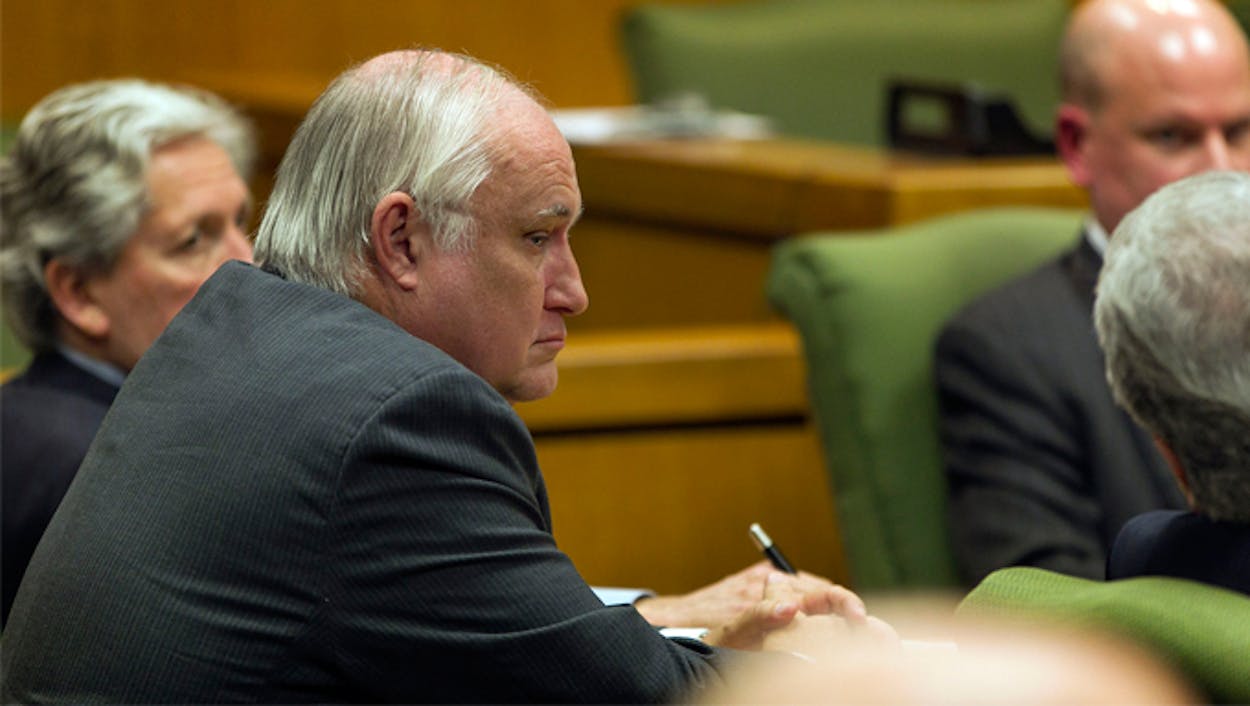The news last Friday that former Williamson County district judge Ken Anderson would have to serve jail time and forfeit his law license for withholding exculpatory evidence in the Michael Morton case was initially heralded as historic and unprecedented.
Anderson, who prosecuted Morton in 1987 for the murder of his wife, Christine, had long insisted that he had committed no wrongdoing, even after Morton was exonerated in 2011 by DNA evidence. But last week he finally capitulated, pleading no contest to felony charges of criminal contempt of court. The New York Times opined that Anderson’s ten-day jail sentence was “insultingly short” in comparison to the nearly 25 years that Morton spent behind bars, but added that “because prosecutors are so rarely held accountable for their misconduct, the sentence is remarkable nonetheless.” Mark Godsey, the director of the Ohio Innocence Project, took to the Huffington Post to declare that this marked “the first time ever” that a prosecutor had been sent to jail for withholding evidence. “What’s newsworthy and novel,” Godsey wrote, “is that a prosecutor was actually punished in a meaningful way for his transgressions.”
But as the news of Anderson’s plea deal spread on social media and throughout the blogosphere, the overwhelming consensus seemed to be that Anderson had gotten off easy. A Wonkette headline succinctly summed up the public’s reaction: “Good News: Prosecutor Does Time For Misconduct! Bad News: 10 Days When Victim Rotted For 25 Years!” The Austin-based criminal justice blog Grits for Breakfast dubbed Anderson’s punishment “tepid justice,” noting that though Anderson had to forfeit his law license, his career had hardly been cut short; he had practiced law for more than three decades, first as a prosecutor and later as a district judge, and will, despite a felony conviction, retain his judicial pension. “A prosecutor going to jail for Brady violations may be a first, but compared to what Morton faced, it’s hard to say with a straight face that Anderson [was adequately punished],” wrote Grits’s editor, Scott Henson.
Defense attorneys also voiced their disappointment and their belief that Anderson’s relatively paltry punishment would never serve as a deterrent. Scott Greenfield argued on his blog Simple Justice that Anderson’s punishment was “an outlier” and that real change would not occur “until ten line prosecutors a year face consequences for Brady concealment.” Houston defense lawyer Robert Fickman took an even more cynical view. “No DA will be deterred by this ten-day sentence,” he wrote on the blog Defending People. “Hell, some of them would do ten days to win a big case.”
Texas Monthly readers familiar with the stories I wrote in 2012 about Morton’s case were particularly incensed by the brevity of Anderson’s sentence, and took to our Facebook page to register their disgust.
Regardless of whether justice was served, a single, extraordinary fact—which was announced last Friday after Anderson’s plea, though it garnered little attention—will ensure accountability. Innocence Project director Barry Scheck told reporters that the current Williamson County D.A., Jana Duty, had agreed to allow an independent review of every single case that Anderson had ever prosecuted. The audit will hopefully answer the question that many people have wondered since Morton’s exoneration in 2011. Was Anderson’s misconduct in the Morton case the exception or the rule?
Such an audit would be unusual for any district attorney’s office, but for Williamson County, it’s nothing less than extraordinary. During the more than quarter-century in which Anderson and his protégé, John Bradley, ran the office, it was one of the most secretive and adversarial in the state. Now Duty will be allowing some sunlight to shine in, opening Anderson’s old files up to scrutiny.
Patricia Cummings—who served on Morton’s legal team in recent years, and who previously worked under Anderson as an assistant prosecutor—is now working with the Williamson County DA’s office to identify which cases require further examination. “We’re trying to determine how many cases Anderson took to trial in which there was a conviction,” the Innocence Project’s senior staff attorney, Nina Morrison, told me. “Depending on that number, we may look at all of those cases, or we may start with just the ones in which someone is still in prison.” After the scope of the audit has been defined, Morrison said, the goal is to launch an independent examination of flagged cases at no cost to taxpayers. “We’re in discussions with a major international law firm about conducting the review pro bono,” she said. Members of the Innocence Project of Texas and the Texas Criminal Defense Lawyers Association, as well as UT Law School professor Jennifer Laurin and her law students, are also expected to play a role.
The audit is not limited to Anderson. It will also examine other cases in which Bradley—who opposed DNA testing in the Morton case for a full six years—successfully opposed DNA testing.
“In the cases that Anderson tried, the focus will be to examine whether there was material that was favorable to the defense that should have been turned over,” Morrison said. “That’s going to require a review of the full trial record, so each case is going to be very labor-intensive.”
Has the Innocence Project heard from any defendants who feel that they were unfairly prosecuted by Anderson, or any attorneys who believe that their clients’ cases merit further investigation? “We’ve gotten a number of calls and letters from both attorneys and defendants,” Morrison said. “And that’s how this all began—when Michael Morton’s lawyer Bill Allison reached out to us eleven years ago and said, ‘I’ve got a case that’s always stuck with me and bothered me, and I hope you’ll take a look.’”







